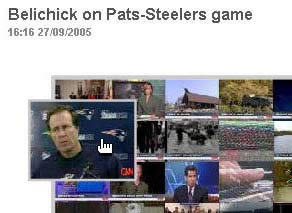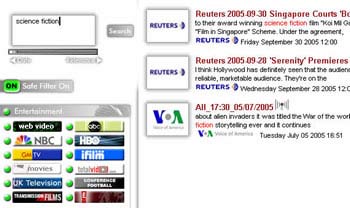Blinkx.tv Offers Modern Version of 1941 'Newsbox'

In his 1941 story Methuselah's Children, science fiction writer Robert Heinlein wrote about a more advanced form of television called a newsbox:
"I wanted to see," said Lazarus, "if there was any news about us-the Families." "I've been watching for that myself. Perhaps we had better use the sound track and let it hunt." "Okay," agreed Lazarus, stepping up and changing the setting to audio. "What's the code word?' "'Methuselah.'" Lazarus punched in the setting; the machine chattered and whined as it scanned and rejected the track speeding through it, then it slowed with a triumphant click. (Read more about Robert Heinlein's newsbox)
A new service at Blinkx.tv provides the capability to search the web for video (and audio) clips. Blinkx claims to be unique among other providers in that you can not only search with standard keywords and Boolean queries, but you can also enter normal text for a conceptual search. The search is done on a transcript of the words taken from the soundtrack of the television video clip - just like in Heinlein's newsbox.
The homepage starts with an interesting application; a large matrix of screen capture thumbnails. Some of them are moving; run your cursor over the moving thumbnail, and get a short text summary. Click on the thumbnail to see the clip.
(From Blinx.tv)
This interface looks quite similar to an earlier effort - see 10x10's User Interface Cooler Than Google's By A Factor Of Ten for more information. Finally, here's a shot of a standard search results page:
(From Blinx.tv)
Blinkx.tv also provides Smart Folders, which reside on your PC. Content is automatically pushed to these folders, based on user-specified criteria, keeping them current for offline viewing. Read more about Blinkx.tv and other similar services here.
Get the world’s most fascinating discoveries delivered straight to your inbox.
(This Science Fiction in the News story used with permission from Technovelgy.com - where science meets fiction.)




